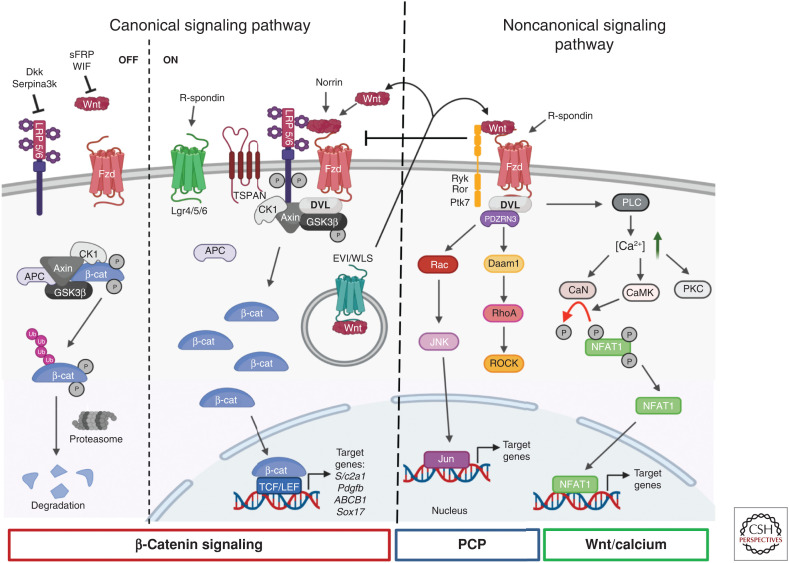Figure 1.
Schematic representation of the canonical and noncanonical Wnt signaling pathways. (Left) Canonical signaling pathway or Wnt/β-catenin signaling pathway. In the OFF state, Wnt ligands do not bind to Frizzled (Fzd) receptors. Thus, cytoplasmic β-catenin binds to its destruction complex formed by glycogen synthase kinase 3β (GSK3β), Axin, adenomatous polyposis coli (APC), and casein kinase 1 (CK1), which induces β-catenin phosphorylation (P), thereby targeting it for degradation by the ubiquitin (Ub) proteasome system. Inhibitors of Wnt ligands (secreted Frizzled-related protein [sFRP] or Wnt inhibitory factor [WIF]) or of coreceptors low-density lipoprotein (LDL) receptor-related protein (LRP5/6) (Dickkopf [Dkk] and serine protease inhibitor [Serpina3K]) contribute to blocking of Wnt signaling. In the ON state, Wnt ligands bind to the receptor complex consisting of Fzd and LRP5/6, which then recruits the Dishevelled (DVL) protein to the plasma membrane. The β-catenin destruction complex is recruited to the membrane, which prevents phosphorylation and degradation of β-catenin. This protein can then accumulate in the cytoplasm and translocate to the nucleus to form a complex with the transcription factors T-cell factor (TCF)/lymphoid enhancer factor (LEF) and stimulate the transcription of Wnt/β-catenin target genes. Wnt secretion is a fine process controlled by the evenness interrupted (EVI)/Wntless (WLS) protein. Other coreceptors (tetraspanin [TSPAN] and leucine-rich repeat containing [Lgr4/5/6]) and ligands (Norrin and R-spondin) can activate or enhance the Wnt signaling pathways. (Right) Noncanonical signaling pathways. Activation of these pathways involve binding of Wnt ligands to the receptor complex formed by Fzd and other key coreceptors (related to tyrosine [Y] kinase [Ryk], receptor tyrosine kinase-like orphan receptor [Ror], protein tyrosine kinase 7 [Ptk7]). Depending on Wnt/Fzd interactions and coreceptors, distinct downstream effectors are involved to transduce alternative β-catenin-independent signaling pathways, namely, the planar cell polarity (PCP) signaling and Wnt/Ca2+ signaling pathways. Activation of the Wnt/PCP pathway leads to the formation of a DVL/Dishevelled-associated activator of morphogenesis 1 (Daam1) complex, which activates the small GTPase RhoA and subsequently Rho-associated protein kinase (ROCK) to regulate actin cytoskeleton. The PCP pathway can also activate the small GTPase Ras-related C3 botulinum toxin substrate (Rac) and then c-Jun amino-terminal kinase (JNK), which then phosphorylates and activates Jun and induces transcription of Jun target genes. The Wnt/calcium pathway involves activation of downstream phospholipase C (PLC), which induces increased release of intracellular Ca2+ levels and then activates protein kinase C (PKC) and Ca2+/calmodulin-dependent protein kinase (CaMK). This last protein can now dephosphorylate the transcription factor nuclear factor of activated T cells (NFAT) leading to its nuclear import and induction of the transcription of its target genes. The calcium pathway can also promote NFAT dephosphorylation and activation through the calcineurin (CaN) axis. R-spondin ligands (more specifically R-spondin3) can also modulate and activate the Wnt/calcium pathway. Created with BioRender.com. (β-cat) β-Catenin, (Ca2+) calcium.

